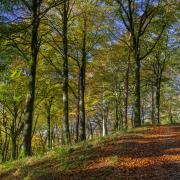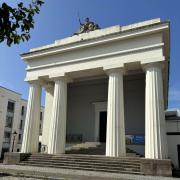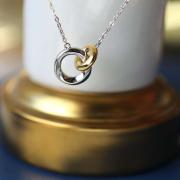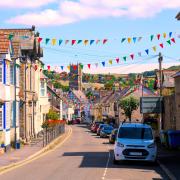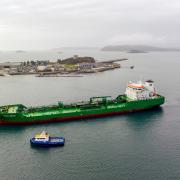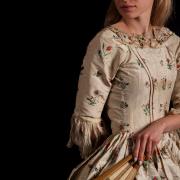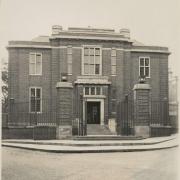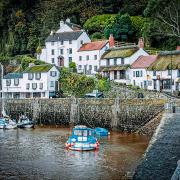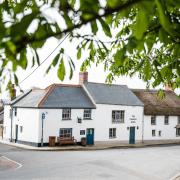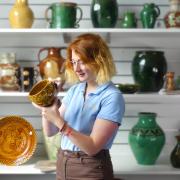‘You might be tempted to sample Fanny’s Bramble.’ says Philip Brind, cracking a smile and waving a hand towards the bar at one end of the barge. ‘In any case, I truly hope you will enjoy something special today.’
This year is the 50th anniversary of the horse-drawn barge at Tiverton. The owners are a husband and wife team. Philip, the skipper, is wearing a red striped neckerchief and a bowler hat with braces over his white shirt. The staff are costumed in country Edwardian-style and Philip’s wife, Jacquie, is wearing a white cotton bonnet. Jacquie is in charge of the ticket office and gift shop, in a stone-built converted stable beside the water, filled with canal folk-art painted items and other souvenirs.
An onboard licensed bar is stocked with a range of alcoholic drinks including local Sandford Orchard ciders, Devon Red, Shaky Bridge and the previously mentioned blackberry flavoured Fanny’s Bramble. They offer a selection of Devon real ales, wine and old-fashioned soft drinks like dandelion and burdock, elderflower lemonade, and ginger beer as well as tea, coffee and hot chocolate.
The canal barge is painted traditionally: green, with Roses and Castles motifs, picture panels and yellow and red trims. An assorted group of passengers are onboard today, including children on their school holidays with their grandparents.
I hear the slow clop of the heavy horse arriving before I see it. We are asked to mute our phones to avoid any 21st century disturbances to what might be ‘a journey 200 years back in time’, if we allow it to be. Philip introduces us to Maddie, the barmaid, and Lauren, the horse ‘man’, who is wearing a Peaky Blinders-style cloth cap, and is in charge of George, our horse today.

It is drizzling at the start, but this mist of moisture is not enough to save the parched grass. It has been a dry spell and our wildlife is suffering. Nevertheless, the edges of the canal are brimming with bulrushes and yellow floating heart. Cow parsley and common hogweed fatten the banks, although some of the umbellifers are starting to turn brown. Occasional gaps in the heavy vegetation reveal the iron-rich, red Devon soil. And masses of yellow flag iris seed pods, looking like something from The Day of the Triffids, have yet to open and spill their seeds into the water.
Lauren and Philip untie the moorings and give us a push off. Momentum is easily created in the water and enables heavy loads to be carried with comparative ease. George, in his colourful hames-and-bobbins harness, is still munching on the hedgerow but he is about to be put to work.
The windows are pulled all the way down, allowing us a multi-sensory encounter with the banks of the canal, including the far side, the side less travelled, the one we don’t usually get to see close up. A swan’s feather is washed aside as we pass through, and occasional waterlilies float showily on the surface. The sound of the water trickling against the sides of the barge is soothing. Cyclists, walkers and their dogs are on the towpath.
A swan protests with an explosive snort and hiss as we pass by, and a small white butterfly pirouettes above the montbretia flowers. Broad-leaved sycamore, beech and oaks line the towpath and ferns cluster in the cooler, shadier areas under bridges. We stop by Warnicombe Bridge for George to have a little break and a nosh. This bridge is not for cars or people, but instead is a farmer’s courtesy bridge for livestock, built at the same time as the canal when it divided farms in two.
George is a hardy 16-year-old Welsh Cob measuring 15.2 hands. He has been with them for seven years. George apparently adores his food and Lauren jokes that he needs to work off some of his winter weight. They have three geldings. The other two are currently enjoying time at pasture on their day off. Each horse works two to three days per week. They will generally serve into their twenties and live into their thirties.

The canal along here was built by hand with pickaxes and shovels, between 1810 and 1814. It was mainly used to ship lime from Burlescombe to the basin where the lime kilns were. There were once 13 or 14 lime kilns in the Tiverton Basin, but now only one remains, for show. The canal boats also transported building materials to Tiverton, a thriving and expanding market town. The boats would have been ‘tub boats’ rather than barges. They were smaller but would often be tied together with several in a row, and they were more likely to be pulled by donkeys, pit ponies, mules or smaller horses. Historically, the animals would be worked hard, all day and all week. George, and his fellow Shire horses, have a much easier time of it.
Once we get going again, we are pulled in reverse until we reach the winding hole (or turning point). On the way back, the skipper encourages quiet, urging us to experience a trip back in time in ‘pin drop silence’.
‘Not much has really changed along here in the last two centuries,’ says Philip.
George’s hooves plod solidly on the towpath. A coal tit calls from within the dense, bindweed-covered hedges and crows caw from the fields beyond. The scent of meadowsweet rises from the bank as we brush past and a plump of moorhen chicks seek shelter under the exposed tree roots in the water. Oak leaves whisper in the breeze above and there is a distant growl of farm machinery. The long grasses with frilly tutus reach like fingers stroking the barge as we go by, and the plants in the water are rocked to-and-fro in our wake. It is a few perfect moments of tranquility.
Under the next bridge, the stonemasons’ markings are etched into the stone. The men were often illiterate but needed markings so that the tally man, when calculating his labour costs, could work out who did what.
The canal was originally built to be 5-6ft deep, but with the layer of silt having gathered at the bottom, its depth is now around 2-3ft. It is still fed by freshwater springs at Fenacre Bridge and Waytown Tunnel, near where the canal ends at Lowdwells. There are culverts along the way to keep control if water levels get too high.
The canal rangers wave as we pass by their boat. On the side there is a concentration of gunnera with its large and deeply lobed leaves, and a willow tree drooping all the way into the water as if it is quenching its thirst. A quarrel of sparrows flies over the teasel and nodding buddleia on the bank as a wood pigeon eyes the scene from a tree-top position.
We approach the Tiverton Basin, and the bell rings for last orders at the bar.
Philip says: ‘Some people return year after year, seeing it as a chance to forget about the pressures, hustle and bustle, we all have in today’s fast and sometimes stressful life. Slowing people down to two and a half miles an hour is an honour for me. In this hectic world, we’ve forgotten what two and a half miles an hour is like.’
Lauren ties off the rope to the mooring and we start to disembark, while Philip shakes everyone’s hand as they exit. The barge attracts a loyal following who are keen to see that this important part of our heritage is preserved. During the pandemic, the business relied upon loans to stay afloat. I am told there are only two other horse-drawn barges left in the country, and enterprises like these are always at risk from the forces of modernity and increasing costs. The welfare of the horses is rightly prioritised here and their winter keep is a major expense. Keeping them exercised and fed on organic hay out of season is a crucial, behind-the-scenes part of the business, and the horses have their vet and dental check-ups then too.
I know the canal well, having walked along this stretch for many years, seeing it in all its guises throughout the different seasons. Viewing this familiar place from water level indulges the senses in a new way, and the experience provides worthwhile perspectives on a piece of living heritage. It was, indeed, special. With or without Fanny’s Bramble.
Open April to October. tivertoncanal.co.uk
Katy Emma Partridge is a writer based in Devon. She also makes eclectic handmade books about nature, travel, art and life. Instagram @katyemmapartridge




